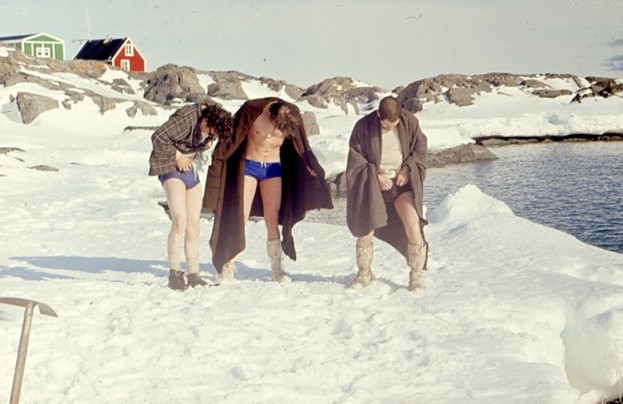
(Photo; Terry Allen)
The FIDS got their opportunity to show their mettle later in the season when one of our brethren developed a lump by his left nipple that rather cramped his style when sledging with the dogs. Bill Taylor describes this episode in some detail here
I understand that the patient survived!
The most common problems presented to the MO throughout the year were strains (especially FIDS back), local blunt injury, cuts and dog-bites.

Less commonly occurring were eczema (one case related to carving a whale-bone), tenosynovitis, and “squits”. Constipation, knee pain, boils, and sore throat closely followed these in the frequency stakes. Inflamed tonsils, sinusitis and frostbite were seldom seen. Burns were a fairly rare occurrence. Needle injuries, usually minor, often related to the preparation of ‘sledging extras’.
Tooth problems among FIDS were not unknown. I dabbled in dentistry on base, extracting and at other times preparing and then inserting some tooth-fillings. The later feedback from UK was rather in the terms of “Who did this?” Metal fillings were a problem when sledging, tending to come loose during sledging. Makeshift re-fitting measures were employed. One favourite was to stick back a dislodged filling with Araldite. A sardine tin made an excellent mixing tray and the small stick for opening the tin transformed into a valuable mixing and application tool.

With regard to frostbite, FIDS were well aware of the danger. Things did not always work out, however. One of our base members was practicing climbing techniques on the ice cliff in Back Bay when a hooley came in and trapped him halfway up the cliff for several hours. In those conditions the rescue attempt took some time, and he remained plastered against the ice-cliff. Eventually he was rescued, but there were some problems with his appendage that had been pressed up against the somewhat cold vertical wall. We only had a bath on base, and not enough hot water for that. In 20 minutes our diesel mech., John, had rigged a shower, by which time water had been heated. The patient then treated us all to a dancing display as the hot water streamed onto the affected part. There appears to have been no long-term harm.
Looking back on it all, the MO provided a service and, moreover, entertainment for the FIDS on base. There was a great level of interest, especially with regard to operations. One long-lasting memory is of a lecture that I gave during the winter on “How to deliver a baby”. Our cook, Dick Bird, was of an appropriate shape, and delighted in acting as a recumbent mother-model, much to the amusement, and indeed, education, of his fellow winterers. Cook and pseudo-baby both recovered well.
